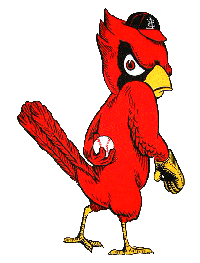
| Illuminations Home |
|
| St.
Louis Cardinals |
|
| Von der Ahe Years |
|
| Gashouse Baseball |
|
| St.
Louis Swifties |
|
| Beginning of the Busch Era |
|
| Gibby
and El Birdos |
|
| Whiteyball |
|
| Enter
"the Genius" |
|
| Baseball Heaven |
|
| Visiting Busch Stadium |
|
| Do the Cubs Really Suck? |
|
Illuminations, Epiphanies, & Reflections
The St. Louis Swifties
|
Nobody
in baseball gave the Cardinals a chance to accomplish much of anything
in 1942, and
before the first pitch of the year was thrown, most baseball writers
had already crowned the Dodgers as the National League pennant winner. In fact, the Dodgers were a great team
that year. They
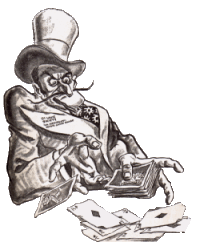 cruised through the first two-thirds of the
season and held a 10 game lead over St. Louis on 15 August. Then,
the Cardinals caught fire, and the Dodgers never knew what hit
them. St. Louis won 43 of their last 51 games to pass Brooklyn on
13 September and finish the year in first place with a 106-48 record
(the Cardinals' best ever season). As far as Brooklyn was
concerned, the Cardinals had stolen the pennant using some type of
slight of hand. William Mullin, the New York based sports
cartoonist, most famous for his Brooklyn Bums character, published a
drawing depicting the Cardinal team as "St. Louis Swifty," a slick,
mustachioed, riverboat gambler, and this nickname stuck too, just like
his earlier caricature of the Gashouse Gang. cruised through the first two-thirds of the
season and held a 10 game lead over St. Louis on 15 August. Then,
the Cardinals caught fire, and the Dodgers never knew what hit
them. St. Louis won 43 of their last 51 games to pass Brooklyn on
13 September and finish the year in first place with a 106-48 record
(the Cardinals' best ever season). As far as Brooklyn was
concerned, the Cardinals had stolen the pennant using some type of
slight of hand. William Mullin, the New York based sports
cartoonist, most famous for his Brooklyn Bums character, published a
drawing depicting the Cardinal team as "St. Louis Swifty," a slick,
mustachioed, riverboat gambler, and this nickname stuck too, just like
his earlier caricature of the Gashouse Gang.Baseball superstitions being what they are, some attributed the Cardinals incredible string of victories to the novelty hit, Pass the Biscuits Mirandy 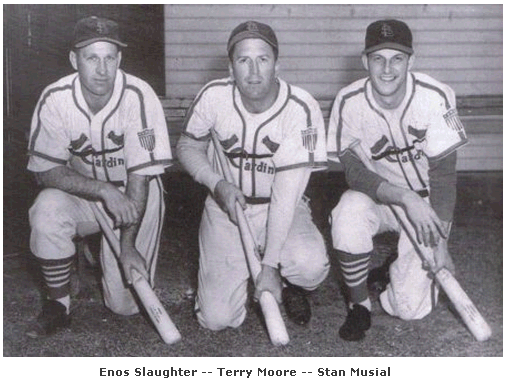 While only Slaughter and Musial hit above .300, the team's pitching was incredible. Mort Cooper ended the regular season with a 1.77 era, a 22-7 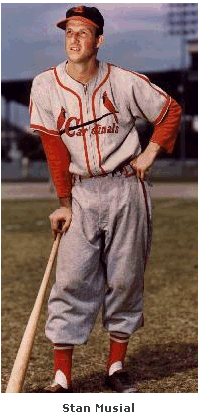 record, and a Most Valuable Player award. The Cardinal
defense was
terrific, and to a man, they indeed were all swift.
As St. Louis sportswriter Bob Broeg noted, "The prize was defense and
pitching depth, highlighted by incredible speed, reflected more in how
many bases they took audaciously than in stolen bases."
record, and a Most Valuable Player award. The Cardinal
defense was
terrific, and to a man, they indeed were all swift.
As St. Louis sportswriter Bob Broeg noted, "The prize was defense and
pitching depth, highlighted by incredible speed, reflected more in how
many bases they took audaciously than in stolen bases." Still, when the World Series began in New York, few thought the Cardinals would stand a chance against Joe DiMaggio and the powerful Yankees. In Game 1, things look bleak for the Redbirds as they were held hitless into the eighth inning by the Yankee starter, Red Ruffing. Then down 7-0 with two outs in the ninth, the Cardinals batted around in the order only to come up short when Stan Musial grounded out with the bases loaded. While the Cardinals lost the game, that inning badly rattled the Yankees and was the turning  point
of the series. The Cardinals swept the next four games.
Game Two ended when Enos Slaughter threw out a runner at third.
Game Three saw Slaugther rob Joe DiMaggio of a probable inside-the-park
homerun with a diving catch; then he and Musial leapt high to pull two
other homeruns back from the stands. The Cardinals ran wild on
the basepaths in Game Four, and Whitey Kurowski, put the Yankees away
in Game Five with a two run homer in the top of the ninth. point
of the series. The Cardinals swept the next four games.
Game Two ended when Enos Slaughter threw out a runner at third.
Game Three saw Slaugther rob Joe DiMaggio of a probable inside-the-park
homerun with a diving catch; then he and Musial leapt high to pull two
other homeruns back from the stands. The Cardinals ran wild on
the basepaths in Game Four, and Whitey Kurowski, put the Yankees away
in Game Five with a two run homer in the top of the ninth. The Swifties streak continued throughout the 1940s as the Cardinals won three more National League Championships and two more World Series titles, beating their in-town rivals, the Browns, in the "Streetcar Series" of 1944 and the Boston Red Sox in 1946. 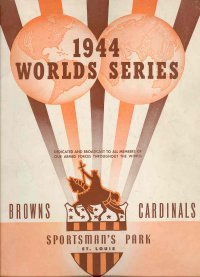 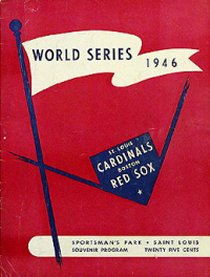 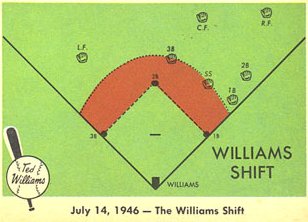 At the start of the 1946 World Series, most of
baseball writers' eyes were on Ted Williams who was expected to give
Cardinal pitching fits. It never happened. The Cardinals
employed the "Ted Williams shift" designed earlier that summer by
Cleveland Indians
manager, Lou Boudreau, and Williams had a miserable
series, batting just .200 with five hits and only one rbi. At the start of the 1946 World Series, most of
baseball writers' eyes were on Ted Williams who was expected to give
Cardinal pitching fits. It never happened. The Cardinals
employed the "Ted Williams shift" designed earlier that summer by
Cleveland Indians
manager, Lou Boudreau, and Williams had a miserable
series, batting just .200 with five hits and only one rbi. One of the most memorable plays in Cardinal history occurred with the score tied 3-3 in the bottom of the eighth in Game 7 against the Red Sox in the 1946 Series. With Enos Slaughter on first, Harry Walker lined a shot into left center field. Slaughter took off with the contact and never looked back. His daring "mad dash" caught the Red Sox cut-off man, Johnny Pesky, sleeping, and Slaughter scored the winning run all the way from first base. 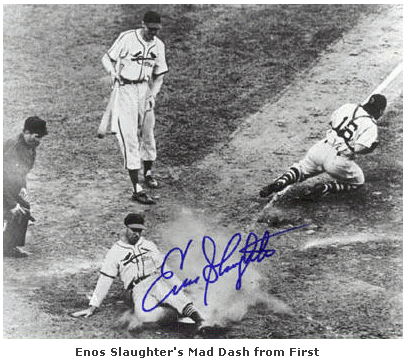 In
December, 1947, Sam Breadon shocked the baseball world by announcing
that he had just sold the St. Louis Cardinals to Robert Hannegan (then
the Postmaster General of the United States) and Fred Saigh, a
prominent regional tax attorney, for $3.5 million, the most ever for a
sports team. At the time,
reporters and fans could not fathom why Breadon made the sale. At
the
press conference announcing the sale, Breadon appeared troubled and
shaken, which was quite unusual for the man who had braved incredible
fan hostility when he traded Rogers Hornsby and sold Dizzy Dean at the
height of both men's fame. Some suspected that Breadon may have
realized the team would be unable to sustain its success without Branch
Rickey, who had left the Cardinals for the Dodgers several years before
following a dispute over business strategy. When questioned as to
why he was selling the
Cardinals just as they had reached their zenith, Breadon, cryptically
responded, "Every day I am less sufficient, and at my age it's time to
quit." The truth was, as all discovered when Breadon died 18
months later, he had recently been diagnosed with prostate cancer.
One year after the sale, Hannegan's health failed as well, and he sold his share of the team to his partner, and Fred Saigh became the Cardinals sole owner. For more information: |